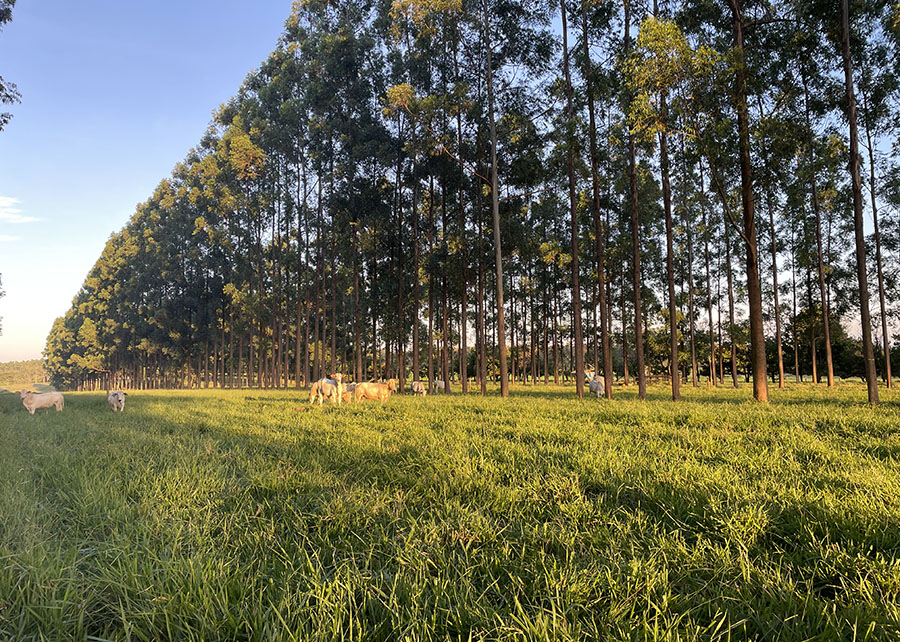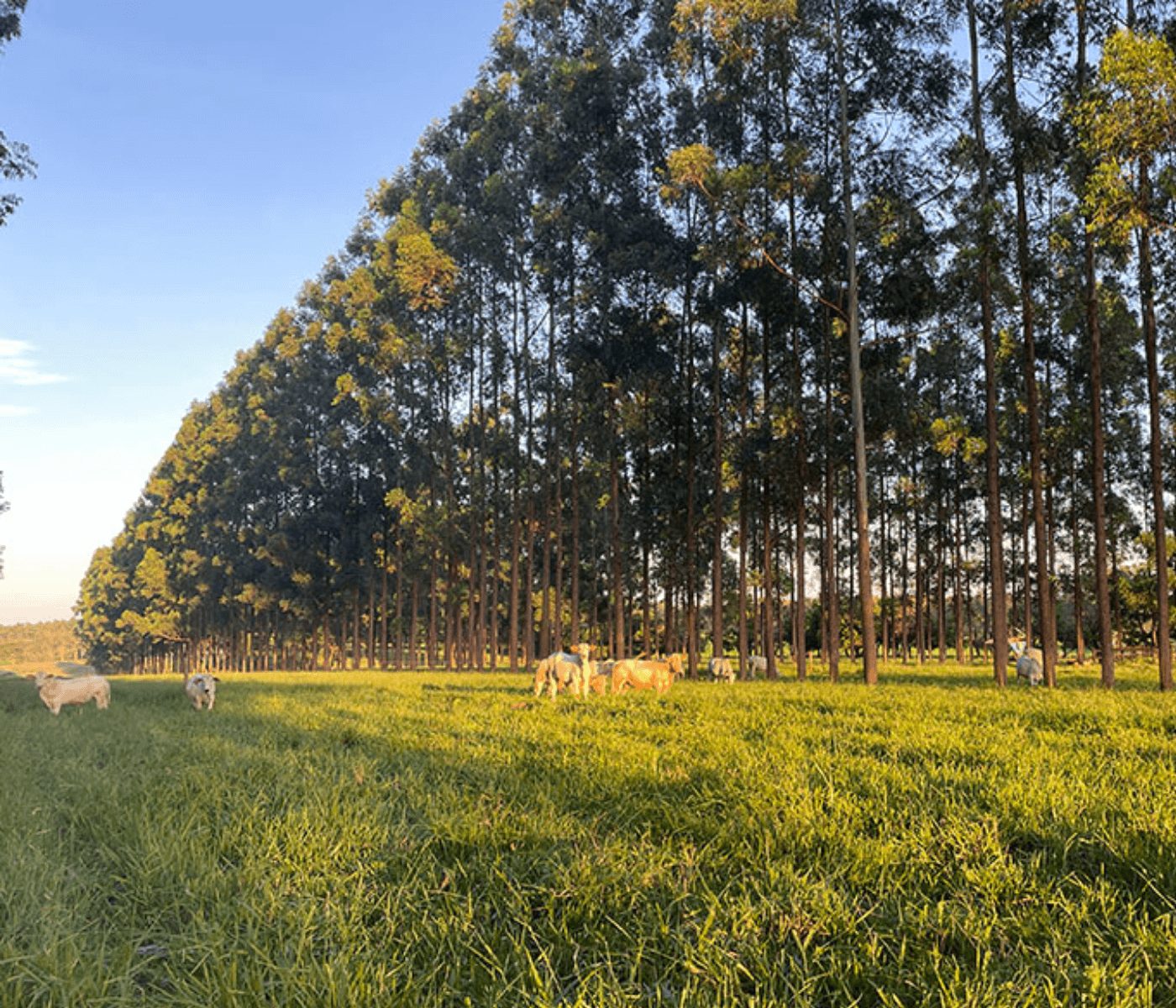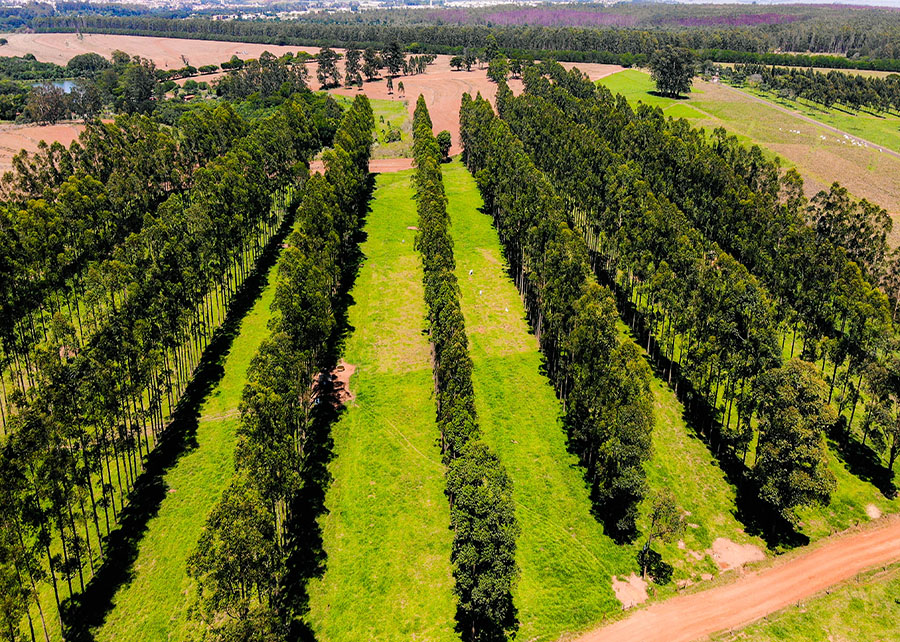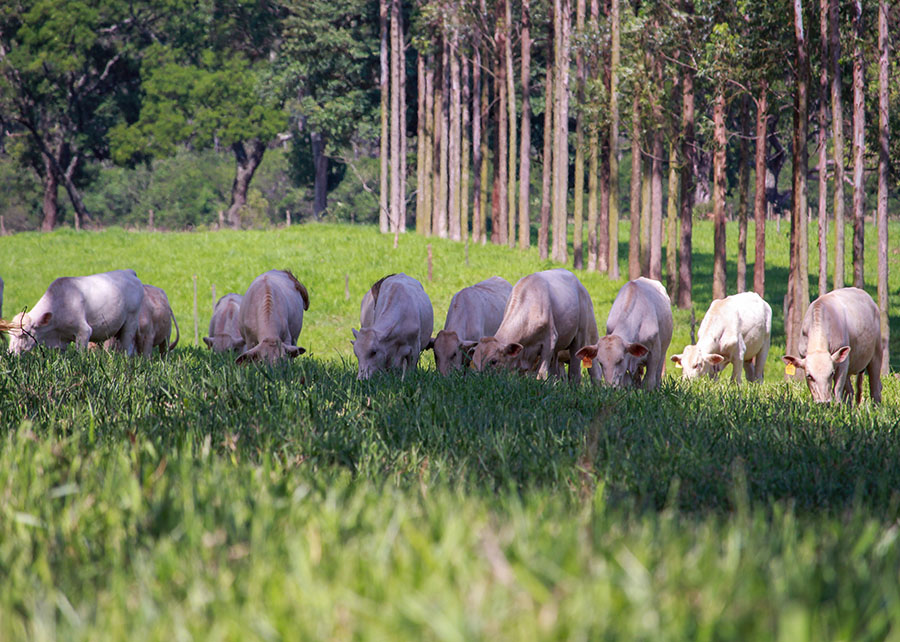
 29 Jun 2023
29 Jun 2023
Silvopastoral systems (SPSs) exhibited pastures with higher crude protein content compared to a traditional livestock model.
A study conducted by Embrapa Pecuária Sudeste (SP) confirmed that tree management is strategic to ensure balance in silvopastoral systems (SPSs). In addition to maintaining pasture productivity and improving the quality of remaining wood, forage in this system exhibited a high crude protein content compared to a traditional livestock model without trees, which indicates higher food quality for animals.
This advancement is significant because maintaining forage production in tree-integrated systems is a challenge for farmers, as pasture development depends on light incidence. Decreased radiation affects the growth of these plants, potentially resulting in lower livestock productivity.

Forage in agroforestry integration showed a high crude protein content compared to a traditional livestock model – Photo: Gisele Rosso | Source: Embrapa.
The research, published in The Journal of Agricultural Science, concluded that shaded pasture has superior nutritional characteristics and similar productivity to pasture managed in full sunlight. (Read the scientific article: Productive and nutritive traits of Piatã palisadegrass after thinning the forest component of a silvopastoral system in southeastern Brazil)
According to Embrapa researcher José Ricardo Pezzopane, tree management in silvopastoral systems led to increased forage production compared to previous years. Prior to thinning, using the average of two seasons—two summers—which is the most productive period for pasture, forage production in the silvopastoral system was 45% lower than in the full sunlight system: 996 kilograms per hectare compared to 1.87 thousand kilograms per hectare, respectively. In the two summers following this management, the production was quite different: almost 2 thousand kilograms per hectare in the integrated model and 2.38 thousand kilograms per hectare in full sunlight. Pezzopane states that there is no statistical difference in this case.
“In addition to no variation in production, forage in the silvopastoral system had higher crude protein content, which indicates better pasture quality for animals. It is important to note that both systems were managed under the same type of rotational grazing, that is, with nitrogen fertilization of the pasture,” explained the researcher.
Practices such as thinning or pruning are options to reduce resource competition between pasture and trees, ensuring balanced production among all elements of the system.
Study
The study evaluated the productive and nutritional characteristics of Piatã grass (Urochloa brizantha cv. BRS Piatã) after thinning the forest component of the silvopastoral system, which consisted of eucalyptus (Eucalyptus urograndis clone GG100). Forage production and nutritional value, along with microclimate variables, were analyzed in the intensive full sunlight system with Piatã grass. The trial took place at Fazenda Canchim, the headquarters of Embrapa Pecuária Sudeste, in São Carlos (SP), from 2016 to 2018.
The silvopastoral system was established in 2011, with trees planted in single rows spaced 15 meters by 2 meters, totaling 333 trees per hectare. Prior to the start of the study in 2016, 50% of the eucalyptus trees were removed from each row, reducing the spacing to 15 meters by 4 meters. According to research data from October 2017, the trees had an average height of 27.8 meters and a diameter at breast height (DBH) of 25.9 centimeters.
During the experimental period, the nutritional value and forage production were evaluated in five representative grazing cycles corresponding to the seasons from December 2016 to March 2018: summer, autumn, winter, and spring of 2017, and summer of 2018.
Results
The crude protein content was higher in the silvopastoral system than in full sun in most seasons. However, the forage accumulation in both systems was similar. Forage production was favored by thinning, especially near the event, while its quality was consistently higher in the silvopastoral system.

Photo: José Pezzopane | Source: Embrapa
When farmers can efficiently use livestock and timber production in the same area, they enjoy various benefits. In addition to the alternative income from timber, there are ecosystem services such as species diversification and carbon fixation (C), which are often not accounted for.
However, Pezzopane warns that this model is quite complex because there are varied interactions among the elements: pasture, trees, and animals. “Positive results depend on the ability to ensure synergistic interactions between these components,” he states.
Producer Maria Fernanda Guerreiro, who has been working with integrated systems on her property since 2013, confirms the results of the Embrapa research in practice. She mentions that she has never had problems with shading from the trees because she always performs thinning. In addition to being a producer, Guerreiro is an agronomical engineer.
“I have a photosynthetically active radiation (PAR) light meter on the farm. So, I never had problems with shading in the pasture, quite the opposite, I only had benefits. I worked with pruning and thinning of the eucalyptus trees. When the meter showed shading exceeding 35%, we implemented a management approach. We removed the thinner and diseased plants, and thus, I had no problems,” she explains.
According to her, it is possible to visually perceive when management is needed; there is no need to have a radiation measurement device. It is necessary to observe and be attentive to all elements.
The right time for management is indicated by the level of light retention by the trees. Pezzopane recommends constant monitoring, and if it exceeds 35%, thinning should be done. Monitoring growth diameter and height, also helps to determine the ideal management point. Other indicators are the stabilization of tree growth, pasture vigor, and opportunities for wood exploitation for on-site use or sale.

Photo: Juliana Sussai | Source: Embrapa
The pasture quality in the silvopastoral system is related to higher soil fertility compared to intensive full-sun systems due to the diversification of soil organic matter (SOM) and its microbiota through root detachment of various species and litterfall. According to the study, SOM and its carbon result in a varied nitrogen mineralization rate, benefiting long-term nitrogen supplementation for plants.
“This factor, along with the physiological changes caused by shading, generally results in species with higher crude protein content and in vitro digestibility of dry matter compared to those managed in full sunlight, which explains the higher crude protein content of the forage in most seasons when compared to positions in the intensive system under full sunlight,” details the researcher.
“In addition, the presence of trees reduces surface runoff and allows for the exploration of deeper soil layers for water uptake, which, under conditions of adequate water availability, increases the total water use by the system. Furthermore, shade reduces radiation and thermal stress on cattle, which can lead to improved animal performance,” the researcher indicates in the study.
In shaded environments with lower temperatures, enzymes exhibit reduced efficiency compared to pastures exposed to full sunlight during the process of photosynthesis. The decrease in efficiency results in a higher concentration of enzymes per leaf mass, and since a significant portion of leaf nitrogen is present in photosynthetic enzymes, there is a higher content of this nutrient in the leaf tissue.
The higher digestibility in silvopastoral pastures can be partially attributed to higher temperatures in the full sunlight system compared to the integrated system. Heating often increases the fiber content of forages, which reduces their quality and digestibility. High temperatures also promote the faster development of forage plants. Thus, it is possible that the pasture in the silvopastoral system was physiologically less mature than the pasture in full sunlight. This, in turn, contributes to higher digestibility since this characteristic of pasture generally decreases with the age of the plant.
Tree management brings more quality and productivity
Source: Embrapa
You may also like to read: “Sustainable and environmentally friendly food systems.”
Subscribe now to the technical magazine of animal nutrition
AUTHORS

Nutritional Interventions to Improve Fertility in Male Broiler Breeders
Edgar Oviedo
The Use of Organic Acids in Poultry: A Natural Path to Health and Productivity
M. Naeem
Synergistic Benefits of Prebiotics and Probiotics in Poultry, Swine, and Cattle
Gustavo Adolfo Quintana-Ospina
Hybrid Rye Potential in Laying Hen Feed Rations
Gwendolyn Jones
A day in the life of phosphorus in pigs: Part I
Rafael Duran Giménez-Rico
Use of enzymes in diets for ruminants
Braulio de la Calle Campos
Minerals and Hoof Health in the Pregnant Sow
Juan Gabriel Espino
Impact of Oxidized Fats on Swine Reproduction and Offspring
Maria Alejandra Perez Alvarado